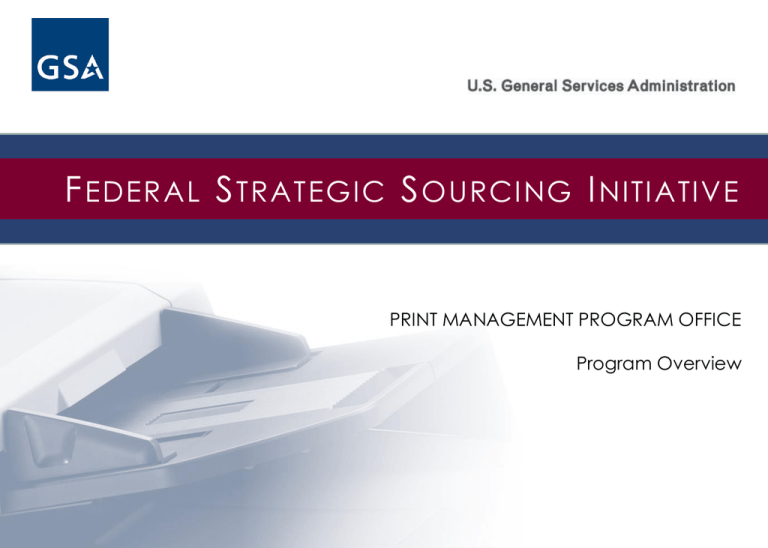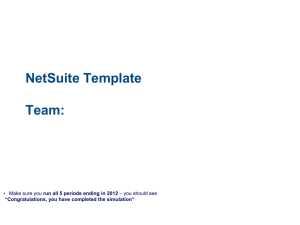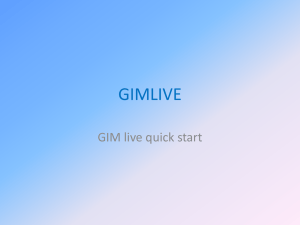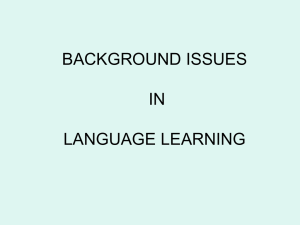Federal Strategic Sourcing Initiative
advertisement

F EDERAL S TRATEGIC S OURCING I NITIATIVE PRINT MANAGEMENT PROGRAM OFFICE Program Overview The Federal Strategic Sourcing Initiative (FSSI) promotes an effective acquisition system to meet government needs & ensure prudent use of taxpayer dollars FSSI VALUE DRIVERS DRIVES EFFICIENT GOVERNMENT OPERATIONS IMPROVES VENDOR PERFORMANCE SUPPORTS ADMINISTRATION GOALS • Lowers Total Cost of Ownership • Enables better and more informed decisions by employees • Minimizes complexity • Increases clarity of requirements • Optimizes supplier relationships • Improves competition & contract structures • Drives achievement of sustainability and socio-economic goals • Helps agencies achieve Administration savings targets • Increases transparency & accountability SUMMARY OF FSSI SOLUTIONS FSSI SOLUTION KEY BENEFITS • Savings estimated at ~$50M per year Office Supplies • Incorporation of POS terms to increase ease-of-use • Improved socioeconomic and green performance Domestic Delivery Services • Savings of $40M+ per year • Increased visibly into shipping patterns and hidden feeds • Identification of “optimal” rate plans based on analysis of usage Wireless TEMS • Reduced inventory costs and billing errors • Pilot programs in place at VA and GSA Print Management • Savings estimated at 25% 40% to date GSA is leading a cross-agency FSSI Commodity Team to develop a governmentwide strategic sourcing solution for Print Management strategy overview | 2 In FY2009, a Commodity Team was formed to develop a strategy to reduce the costs of network and personal printers, copiers, and multi-function devices Traditional agency management approach Traditionally managed by CIO Office Network Printer Traditionally managed by facility / administrative staff Multi-Function Device (MFD) / Multi-Function Printer (MFP) Best practice is to manage as IT equipment Desktop Printer Stand Alone Copier / Stand Alone Fax Best practice is to eliminate / minimize use Best practice management approach Agencies can adopt the FSSI Print Management solution for their entire enterprise fleet, for only printer or copiers/MFDs, or for individual office locations (or any combination thereof) strategy overview | 3 Over twenty-four agencies and organizations collaborated to develop a Print Management program which meets the needs of the Federal community REQUIREMENTS DEFINITION & ACQUISITION STRATEGY TEAM • Defense Logistics Agency • Department of Agriculture • Environmental Protection Agency • Department of Commerce • Executive Office of the President • Department of Defense • Federal Aviation Agency • Department of Homeland Security • Food & Drug Administration • Department of Energy • Environmental Protection Agency • Department of Health and Human Services • General Services Administration • Department of Justice • Internal Revenue Service • Department of Labor • NASA • Department of State • Peace Corps • Department of Transportation • Small Business Administration • Department of Treasury • US Department of Agriculture ADDITIONAL CONTRIBUTORS • Office of Management and Budget • Office of Federal Procurement Policy • Various industry groups • Department of Veterans Affairs strategy overview | 4 The program is comprised of three interrelated components to lower the Total Cost of Ownership of print devices FIRST GENERATION ACQUISITION STRATEGY An easy to use procurement vehicle for all print devices & services that will deliver savings and enable improved agency print management BEHAVIORAL CHANGE STRATEGY A set of guidelines and tools to increase awareness of print costs and best practices to drive improved employee decision making CONTINUOUS IMPROVEMENT STRATEGY Ongoing engagement, collaboration and facilitation of print management evolution through a government-wide community of interest strategy overview | 5 FSSI Commodity Team analysis has shown that the “sticker price” of print/copy devices is only a small fraction of the Total Cost of Ownership (TCO) ESTIMATED PRINTER / COPIER / MFD TOTAL COST OF OWNERSHIP FOR FY10 $2,500M 2,000 1,500 1,000 Although device vendors do not commercially provide paper, data collected through the solution will enable agencies to manage this spend 500 Consideration of consumables is critical to understanding the TCO of print devices $623M $1,041M •Due to similarities in the drivers of TCO and trends in the supply market, the scope of a Print Management strategy should include both printers and copiers/MFDs $2,082M $23M Estimate Based on Market Analysis Estimated Based on Usage GSA Advantage $169M $225M FPDS Purchase & Lease Paper The direct costs for devices are a small fraction of TCO Toner Other Direct Costs Support Costs IMPLICATIONS Total Cost of Ownership Support costs are generally proportional to the number of installed devices & the approach used to manage the devices Source: FPDS Spend Data for FY08 , GSA Advantage Line Level Spend Data for FY08, Censeo Analysis Notes: 1) Other Direct Costs include maintenance agreements outside of lease contracts and other consumables such as toner drums 2) Support Costs include downtime costs; time to order consumables; device acquisition costs; asset management; support & help desk •Agencies will benefit from ensuring visibility to enable acquisition decisions based on TCO • Device costs • Toner costs and yield • Energy costs • Maintenance costs • End-of-life costs •“Right-sizing” the print fleet would drive significant savings, but is not a prerequisite for implementation of a Print Management solution potential acquisition strategy | 6 The Commodity Team has developed an acquisition that will enable agencies to reduce the size of their print fleet and lower printing and copying costs RFQ Component Fleet Assessment “Device Plus” Products / Services Key Benefits Identification of all print devices in an agency / bureau / location •Enables agencies to understand total print costs and carbon impact of operating the print fleet Analysis of optimal number, type, and placement of devices based on agency printing patterns •Improves employee access to print devices while lowering total costs •Typically results in reduced total number of deployed print devices (lowering costs and electricity consumption) Compliant print & copy devices with low Total Cost of Ownership •Ensures all print devices comply with security, accessibility, and environmental requirements •Provides access to devices with the lowest total costs Consumables •Reduces redundant contracts & enables complete understanding of print costs •Enables agency evaluation of total operating costs (not just device “sticker price) Service and Maintenance •Ensures device uptime & availability •Minimizes burden on agency CIO staff Vendor Data Collection & Reporting •Provides visibility into agency purchase and usage patterns •Enables rapid creation of reports to comply with OMB / Executive Order requirements strategy overview | 7 The Print Management program will support Federal sustainability, budgetary and operational goals BENEFITS OVERVIEW Operational Budgetary Sustainability Objective Improved environmental performance Compliance with Executive Order 13514 Over $1.1B in annual savings Complexity reduction & security management Improved mission focus Description Projected annual paper reduction equivalent to up to 550,000 trees Auditable reduction in electricity consumption Alignment with EO requirements including improved transparency, electronic product stewardship, and waste reduction Savings from short and long term behavioral changes are projected at up to $700M government-wide, driven by improved device selection and reduced consumables costs Support cost savings are projected at up to $450M governmentwide Reduction in number of deployed print devices (includes MFDs) and rationalization of print device models Formalization of security requirements for print devices Increased ability of agency staff to focus on strategic priorities and mission delivery rather than the tactical management of print devices strategy overview | 8 The Print Management program will drive sustainability improvements throughout the government Key Sustainability Features of the Print Management Program Sustainability Category Improvement Driver Details Energy STAR & Efficiency All devices must be Energy STAR certified, and energy consumption will be considered when devices are evaluated EPEAT Ratings Minimum EPEAT rating thresholds for printers and copiers will be incorporated into requirements when they have been finalized by EPA Improved Device Energy Settings Devices will be required to have optimized default settings for use of ‘sleep’ mode Reduced Device Footprint Reduction in the number of devices deployed throughout the government Packaging Requirements Requirements will be included to drive minimization of device packaging material and to increase packaging recycled content Recycled Content Requirement Machines will be required to utilize a minimum percentage of recycled content & vendors will be encouraged to use remanufactured toner Device Disposal Machines will be required to be disposed of in an environmentally acceptable manner Reduced Paper Consumption Duplex Printing Requirement Devices will be required to have optimized default settings for use of ‘duplex’ printing Misc. Green Machine CLIN Separate CLIN awards will be made for devices that demonstrate the most advanced sustainability technologies Reduced Energy Consumption & Carbon Emissions Improved Recyclability & End of Life Management strategy overview | 9 Seven change management guidelines are provided to agencies to drive cost savings POTENTIAL GUIDELINE ELEMENTS Category Guideline Overall Savings / Sustainability Potential • Default use of ‘duplex’ (double-sided) printing • Default use of ‘black and white’ printing Changes To Device Settings • Default use of ‘draft’ quality (rather than ‘high’ quality) printing • Improved use of sleep mode Changes To End User Applications Changes To The Print Fleet • Default use of toner-efficient fonts • Potential annual savings of over $320M • Up to 550,000 trees saved per year • Annual carbon reduction equivalent of up to 47,000 cars being taken off the road • Removal of existing personal printers • Purchase freeze for new personal printers The Commodity Team has also developed a tool to enable agencies to track the savings driven by these guidelines potential acquisition strategy | 10 The program is the first step in the government’s evolution to a low-cost, lowprint environment PRINT MANAGEMENT MATURITY MODEL The first generation program provides agencies with the immediate cost savings and green benefits, and captures the data necessary for continued evolution CURRENT STATE: Unmanaged Print Lack of visibility and control over print Total Cost of Ownership Current State (most agencies) Data-driven management FUTURE GENERATIONS: 2nd GENERATION ACQUISITION: Document Lifecycle Management 1st GENERATION ACQUISITION: Continuous Process Improvements IMMEDIATE IMPROVEMENTS: Acquisition Improvement Behavior Changes Improved print decisions by end users Selection of devices based on Total Cost of Ownership and emerging understanding of enterprise print patterns Balancing of print demand with device capability, resulting in net decreases in number of deployed devices and minimized enterprise Total Cost of Ownership Minimization of document print output through use of electronic archiving, workflow management, and other digital technologies Achieved in 90-days through development of behavior guidelines Achieved over multiple years as current agency contracts expire Enabled by the data collected through the 1st generation solution Initial data collection through savings calculator Limited / no data Vendor collection & reporting of detailed usage data Data centricity Long term Commodity Management objective strategy overview | 11 The Commodity Team is on pace to award an acquisition vehicle by midAugust with program kickoff occurring by August 30 2011 APR MAY JUN JUL AUG Implementation Planning Final RFQ Edits Draft RFQ RFQ Release to Industry and Vendor Bids Implementation Evaluation & Preparation for Program Launch SSWG Review OFPP Review SEP Notify Industry Award Support of Agency Guideline Implementation Today KEY DATES • • SSWG Review – June 9 RFQ Posted – June 16 • • • Evaluation (Crystal City) – August 8-10 BPA Awards – August 18-19 Program Launch – August 30 Commodity Team Meeting | 12 Agencies can help the Print Management program achieve its cost savings and sustainability objectives FESWG SUPPORT REQUESTED • Champion and support the Print Management program within your respective agencies • Adopt the seven steps to lowering print costs within your agency • For agencies who are not currently represented on the Commodity Team, identify potential team members and submit names to print.management@gsa.gov strategy overview | 13










